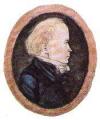Biography
Erik Johan Stagnelius was a Romantic poet and playwright.
1810 to 1840 was a blossoming time in Swedish poetry, and there were several writers of distinguished merit, among them Esaias Tegnér, Erik Gustaf Geijer, Per Daniel Amadeus Atterbom and Erik Johan Stagnelius. The brief and mysterious life and death of Erik Johan Stagnelius have given a romantic interest to all that is connected with his name.
Life
His father was a vicar on Öland, later on biskop in Kalmar on the nearby main land, which likely influenced Stagnelius spiritual thinking. He came from a large family. Stagnelius showed a natural gift for poetic writing from an early childhood. He took his Bachelor's Degree from Uppsala University in 1814 and got an employment as a clerk in Stockholm. As a person he was said to have been unattractive and unkempt. A woman who knew him, said of his appearance "where in this shabby person lies the beauty which his poetry expresses?".
He was notably gloomy and lived alone for most of his life, although he seemed to flourish during brief visits to his home town. As he first arrived to Stockholm, he strived for success as a poet, but basically this did not come until after his death.
His first publication was the epic of Wladimir den store (Vladimir the Great; 1817); followed by the romantic poem Blenda. His singular dramas, Bacchanterna (The Bacchantes; 1822), Sigurd Ring, which was posthumous, and Martyrerne (The Martyrs; 1821), are esteemed by many critics to be his most original productions. His mystical lyrics, entitled Liljor i Saron (Lilies in Sharon; 1820), and his sonnets, which are best read in Swedish, may be recommended as among the most delicate products of the Scandinavian mind.
It is believed that he suffered a chronic physical condition (Noonan syndrome have been suggested by Swedish researchers) causing him increasing pain, and that he used opium as his main remedy. On the details of his life, little is known. He had only a few friends, and no female companionship. At his death in Stockholm at the age of 29, no relatives were present at the funeral.
Poetry
Stagnelius has been compared, and not improperly, to Shelley. Several of Stagnelius poems were translated into English by Edmund Gosse (1886). The bulk of his poetry was found in a sack in his shaddy apartment, after his death. They were almost sent to be burnt, but were instead kept, and several are still being appreciated today for their romantic and mystic/spiritual qualities. The perhaps best known are the poem "Näcken," a romantic verse-based poem about the Nix; Till förruttnelsen (For Decay) and Resa Amanda, jag ska (Go Amanda, I will).
Philosophy
His thinking, which is evident from his later works, is influenced by mystics and romantic philosophers. Partly, he was also influenced by gnostic beliefs. Not proper, perhaps, in the Christian 19th century Sweden, this possible belief has been thoroughly examined, and is believed to have originated by a reading of the Swedish translation of Ginza Rba, the holy works of the Mandaeism, published as Adam's Book. Other persons whose works he read and were likely influences were Schelling, Jakob Böhme and Plato. ..






